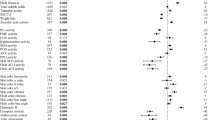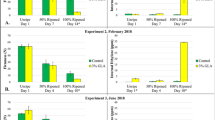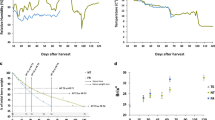Abstract
MANY theories have been proposed to explain the nature of the climacteric rise in respiration seen in most ripening fruits. They include changes in tissue organization which lead to increased metabolism1, or effects of mitochondria which cause a loss of respiratory control2. The role of ethylene in the induction of ripening has now been confirmed but, in spite of much attention, the physiological nature and significance of the climacteric have remained elusive3. Although fruit tissues undergo many changes during ripening4, much biochemical organization is retained; mitochondria do not lose their respiratory control2 and protein synthesis continues up to the climacteric maximum5–7. Ripening has therefore been interpreted as a process requiring considerable cellular work, so that the climacteric is merely the respiratory summation of cellular energy requirements3. In many fruits, however, the energy requirements for the largely catabolic events of ripening must be very small. In the banana, for example, which shows a classical respiration climacteric, starch makes up as much as 20 per cent of the fresh weight before ripening8. During ripening, the starch is almost completely hydrolysed by phosphorylase to sugars (an exergonic reaction). Moreover, it has been shown that the respiratory climacteric can occur in the absence of protein synthesis6.
This is a preview of subscription content, access via your institution
Access options
Subscribe to this journal
Receive 51 print issues and online access
$199.00 per year
only $3.90 per issue
Buy this article
- Purchase on Springer Link
- Instant access to full article PDF
Prices may be subject to local taxes which are calculated during checkout
Similar content being viewed by others

References
Sacher, J. A., Nature, 195, 577 (1962).
Biale, J. B., Science, 146, 880 (1964).
Pratt, H. K., and Goeschl, J. D., Ann. Rev. Plant Physiol., 20, 541 (1969).
Spurr, A. R., Hort. Sci., 5, 33 (1970).
Richmond, A., and Biale, J. B., Arch. Biochem. Biophys., 111, 174 (1965).
Frenkel, C., Klein, I., and Dilley, D. R., Plant Physiol., 43, 1146 (1968).
Rowan, K. S., McGlasson, W. B., and Pratt, H. K., J. Exp. Bot., 20, 145 (1969).
Barnell, H. R., Ann. Bot., 5, 217 (1943).
Burg, S. P., and Burg, E. A., Science, 148, 1190 (1965).
Huelin, F. E., and Barker, J., New Phytol., 38, 85 (1939).
Author information
Authors and Affiliations
Rights and permissions
About this article
Cite this article
REID, M., PRATT, H. Ethylene and the Respiration Climacteric. Nature 226, 976–977 (1970). https://doi.org/10.1038/226976b0
Received:
Revised:
Issue Date:
DOI: https://doi.org/10.1038/226976b0
This article is cited by
-
The fading distinctions between classical patterns of ripening in climacteric and non-climacteric fruit and the ubiquity of ethylene—An overview
Journal of Food Science and Technology (2012)
-
Ethylene in a compacted field soil and its effect on growth, tuber quality, and yield of potatoes
American Potato Journal (1979)
-
Les �changes gazeux de la cerise. Comportement du fruit cueilli soumis � l'action de l'�thyl�ne
Qualitas Plantarum et Materiae Vegetabiles (1973)
-
The influence of storage factors on endogenous ethylene production by potato tubers
American Potato Journal (1973)
-
Treatment of Fruit with Propylene gives Information about the Biogenesis of Ethylene
Nature (1972)
Comments
By submitting a comment you agree to abide by our Terms and Community Guidelines. If you find something abusive or that does not comply with our terms or guidelines please flag it as inappropriate.


